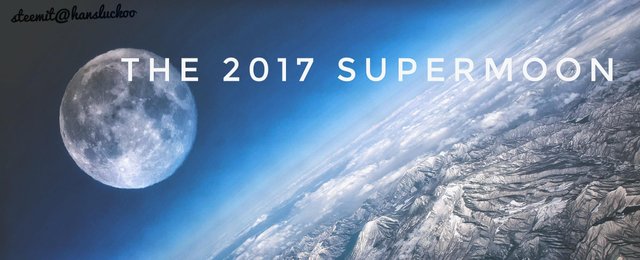The 2017 Supermoon

On this Sunday, stargazers, astronomers and curious sky-watchers will get a chance to witness the first and only supermoon of 2017.
In the not so far, November 2016, the moon reached a distance closest to the Earth than ever seen since 1948, producing a supersized supermoon. But on this Sunday night, the moon will still shine 16% brighter and appear 7% larger than its usual size.
This phenomena occurs when the sun, moon and Earth align, and a full or new moon aligns with the sun's lunar orb. This supermoon will be the first in the series of three consecutive full moon supermoons, the next two to occur in January.
It has already been a year since a visible supermoon last lit up the sky for everyone in the world has a chance to marvel at this upcoming full moon. The majority of astronomers suggest watching the supermoon right after sunset and into moonrise, and minutes before the next sunrise as well.
But for those lazy asses who can't wake up that early, fortunately, the moon will still look bigger and brighter throughout the night. So enjoy.
The science behind the supermoon

Michelle Nichols, the director of public observing at Chicago's Adler Planetarium argues that there is a reason behind the moon's captivating close approach to the Earth.
"The moon's orbit is not a perfect circle. It's more like an oval, so at times it's closer to the Earth than it is at other times. The difference in distance between these close and far points can be as much as about 30,000 miles."
Basically, the distance between the moon and Earth constantly changes. And each time the moon orbits the Earth, every 29.5 days, it will reach a close point to the Earth (perigee), and a far point (apogee), and occasionally, the close point will be close to the date aof the full moon or new moon, a supermoon.
"For this year's final supermoon, the perigee distance will be approximately 222,135 miles in the early morning hours of December 4 (in the United States)," says Nichols.
As it may appear super, the term "supermoon" is not the official term for the astronomical phenomenon. The scientific term is "perigee syzygy." Perigee syzygy has occurred three previous times in 2017. I can't really spell the scientific term so let's stick to the word "supermoon".
December's full moon is the only visible supermoon. This is because the previous two were around the time of a new moon, which isn't visible in the sky.
Don't let your eyes fool you
While the moon is undoubtedly both bigger and brighter than usual, our eyes tend to trick us into seeing the moon as larger than it truly is.
Part of it depends on where you're viewing the supermoon.
"When you look at it from near the horizon, there's an optical illusion,"says Nichols.
When the supermoon is viewed low on the horizon, it appears huge. This is known as the moon illusion and the moon hasn't grown; it's a trick your eyes are playing on you.
An optical illusion may occur when watching the supermoon immediately after sunset (or before sunrise). As at this time, the moon also appears both bigger and brighter than it actually is. This is also why both times are the best for watching the supermoon.
Nichols says that despite the difference between a regular full moon and a supermoon, it is not as grand as it appears.
"If you stretch out your arm at full length, and stretch out your thumb, and compare the size of the full moon in the sky to the size of your thumb, you'll notice the width of the full moon compared to the size of your thumb; you can put four full moons across the width of your thumb."
Considering that a full moon can be covered with a fingernail, even a 7% larger moon may not look that much bigger.